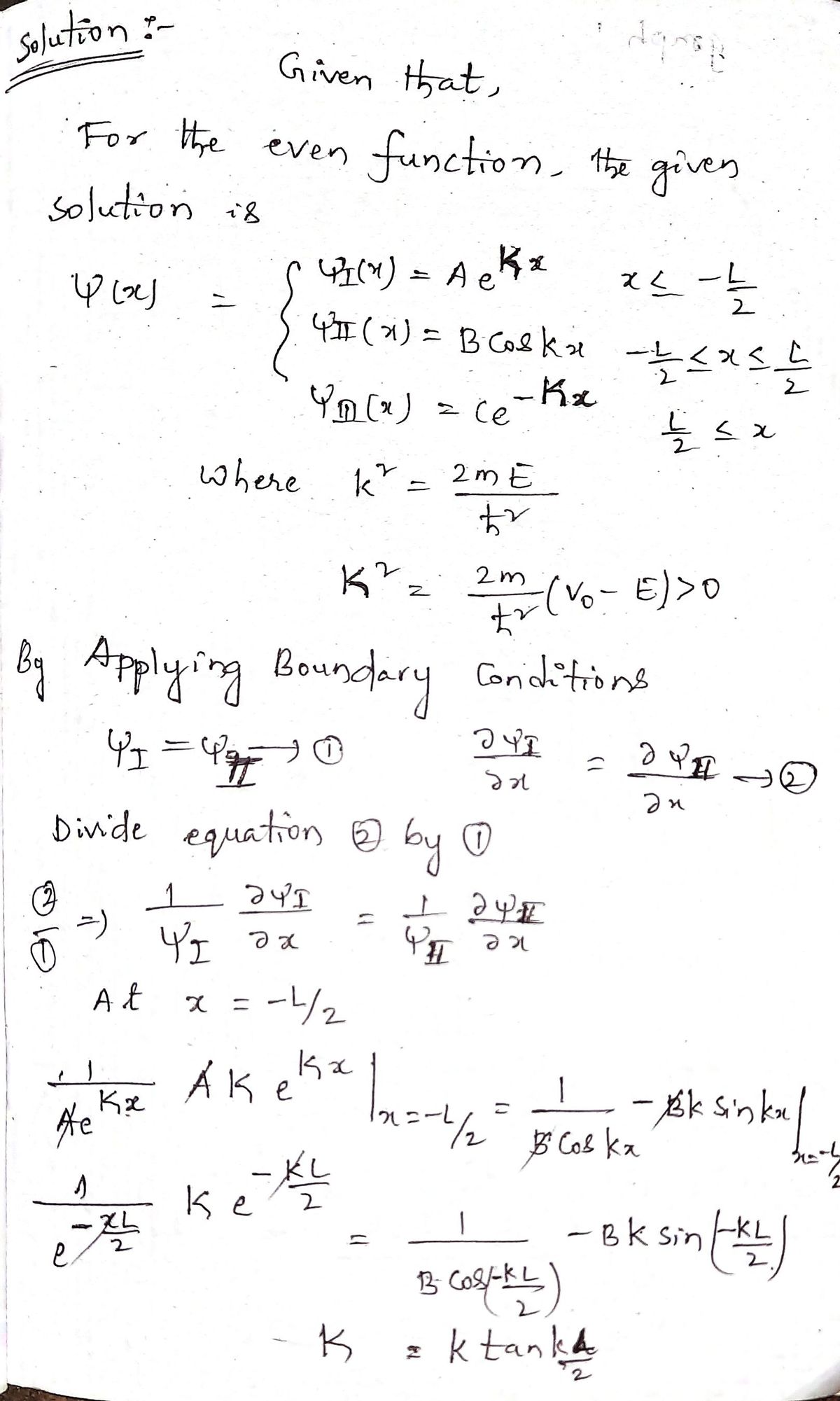3) A Particle Trapped in a Shallow Defect This is a simple model for a shallow trap or defect in a semiconductor, for example, or a more realistic model for a quantum dot. We are interested in the trap states, i.e., states where the particle is localized in the trap. Hence this requires E < Vo where E is the energy of the particle. V (x) Vo air I II L 0 L k²= 2 Since the symmetry of the Hamiltonian is even, parity is a good quantum number and the solutions must be overall even or odd. 2mE For the even solution, use the following solution with A = C: 4₁(x) = A exx (x) = n(x) = B cos kx (m(x)=Ce-xx dif(x) | dx 2 2m K² = - (V- -E) >0 h² For the odd solution, use the following solution with A' = - C': 4₁(x) = A' exx x < (x) = n(x) = B′ sin kx -≤x≤ (4m(x)=C'e-xx 1x=-1/32 You should also apply in each case the continuity conditions: Þ₁ (x = − 1) = 4u (x = − 1 ) Pu (x = + ²) = m ( x = + 2) = III d₁(x)| deficx) =+ =] dx diµ(x)| dx dip(x)| dx L Use these conditions in the solution to find a set of two homogeneous equations of two unknowns. Solve these equations to find a relation between k and x and plot the solutions on a graph.
3) A Particle Trapped in a Shallow Defect This is a simple model for a shallow trap or defect in a semiconductor, for example, or a more realistic model for a quantum dot. We are interested in the trap states, i.e., states where the particle is localized in the trap. Hence this requires E < Vo where E is the energy of the particle. V (x) Vo air I II L 0 L k²= 2 Since the symmetry of the Hamiltonian is even, parity is a good quantum number and the solutions must be overall even or odd. 2mE For the even solution, use the following solution with A = C: 4₁(x) = A exx (x) = n(x) = B cos kx (m(x)=Ce-xx dif(x) | dx 2 2m K² = - (V- -E) >0 h² For the odd solution, use the following solution with A' = - C': 4₁(x) = A' exx x < (x) = n(x) = B′ sin kx -≤x≤ (4m(x)=C'e-xx 1x=-1/32 You should also apply in each case the continuity conditions: Þ₁ (x = − 1) = 4u (x = − 1 ) Pu (x = + ²) = m ( x = + 2) = III d₁(x)| deficx) =+ =] dx diµ(x)| dx dip(x)| dx L Use these conditions in the solution to find a set of two homogeneous equations of two unknowns. Solve these equations to find a relation between k and x and plot the solutions on a graph.
Related questions
Question

Transcribed Image Text:3) A Particle Trapped in a Shallow Defect
This is a simple model for a shallow trap or defect in a semiconductor, for example, or a more realistic model for
a quantum dot. We are interested in the trap states, i.e., states where the particle is localized in the trap. Hence
this requires E < Vo where E is the energy of the particle.
V (x)
Vo
nie
I
II
L
0 L
2
8
k²
||
K² =
Since the symmetry of the Hamiltonian is even, parity is a good quantum number and the solutions must be
overall even or odd.
For the even solution, use the following solution with A = C:
(4₁(x) = A exx
4(x) = 4₁(x) = B cos kx - ² ≤ x ≤
4m(x)=Ce-xx
2mE
2m
h²
(V₁ – E) > 0
dij(x)
dx √x = - 1²/2
2
din(x)
dx
=
For the odd solution, use the following solution with A' = - C':
4₁(x) = A' exx
(x) = {₁(x) = B′ sin kx
B'
m(x)=C'e-xx
III
=
din(x)
dx
You should also apply in each case the continuity conditions:
4₁ (x = -²2 ) = ₁ (x = -1)
Pu (x=+) = m(x=+)
dpm(x)
dx
|x=+12/2
VI
8
-- /
x
VI
212
x≤ - 1²/12
≤x≤
11/27 ≤ x
|x=+23/23
Use these conditions in the solution to find a set of two homogeneous equations of two unknowns. Solve these
equations to find a relation between k and K and plot the solutions on a graph.
Expert Solution
Step 1

Step by step
Solved in 3 steps with 3 images
